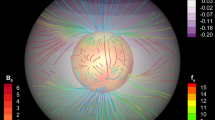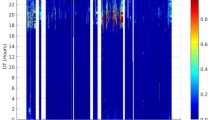Abstract
The Earth’s central plasma sheet plays an important role in mass and energy transport in the whole magnetosphere. Here, we first present a new approach, i.e., an Artificial Neural Network (ANN) model, to investigate the electron number fluxes in the central plasma sheet. With the time series of 8 solar wind/geomagnetic indices and spatial locations as inputs, the model has been trained, validated, and tested with three isolated groups of measurements from Time History of Events and Macroscale Interaction during the Substorm (THEMIS) – A/D/E spacecraft from April 1, 2007 to December 30, 2015. The plasma sheet electron flux is shown to be accurately reproduced by the ANN model with a total correlation coefficient (R) above ∼0.91 and a root-mean-square-error (RMSE) less than 0.36 between the data and model target in a spatial region from radial distance 7 RE to 12 RE (where RE is the Earth’s radius) at the nightside of between 18 MLT through 24 MLT and up to 0.6 MLT (Magnetic Local Time) for energies at 0.06 – 293 keV. Global and spectral distributions of reproduced values can also capture the dawn-dusk asymmetry and the dependence on radial distances of plasma sheet electron fluxes. Our developed artificial neural network (ANN) therefore has a good capability in statistically reproducing the plasma sheet electron fluxes for a variety of substorm activities, and can be readily adopted for building up the boundary conditions for physics-based simulation efforts that model the dynamics of the radiation belt electrons and other parts of the terrestrial magnetosphere.





Similar content being viewed by others
References
Albert, J.M., Bortnik, J.: Nonlinear interaction of radiation belt electrons with electromagnetic ion cyclotron waves. Geophys. Res. Lett. 36, L12110 (2009). https://doi.org/10.1029/2009GL038904
Anderson, C.: The end of theory: the data deluge makes the scientific method obsolete, Wired, June 23, 2008. Available at http://www.wired.com/science/discoveries/magazine/16-07/pb_theory
Angelopoulos, V.: The THEMIS mission. Space Sci. Rev. 141, 5–34 (2008a). https://doi.org/10.1007/s11214-008-9336-1
Angelopoulos, V.: First results from the THEMIS mission. Space Sci. Rev. 141, 453–476 (2008b)
Artemyev, A.V., Petrukovich, A.A., Nakamura, R., Zelenyi, L.M.: Profiles of electron temperature and \(B_{z}\) along Earth’s magnetotail. Ann. Geophys. 31, 1109–1114 (2013). https://doi.org/10.5194/angeo-31-1109-2013
Aseev, N.A., Shprits, Y.Y., Wang, D., Wygant, J., Drozdov, A.Y., Kellerman, A.C., Reeves, G.D.: Transport and loss of ring current electrons inside geosynchronous orbit during the 17 March 2013 storm. J. Geophys. Res. Space Phys. 124, 915–933 (2019). https://doi.org/10.1029/2018JA026031
Baker, D.N., Pulkkinen, T.I., Angelopoulos, V., Baumjohann, W., McPherron, R.L.: Neutral line model of substorms: past results and present view. J. Geophys. Res. 101, 12,975 (1996). https://doi.org/10.1029/95JA03753
Baumjohann, W., Paschmann, G., Cattell, C.A.: Average plasma properties in the central plasma sheet. J. Geophys. Res. 94, 6597 (1989). https://doi.org/10.1029/JA094iA06p06597
Bortnik, J., Li, W., Thorne, R.M., Angelopoulos, V.: A unified approach to inner magnetospheric state prediction. J. Geophys. Res. Space Phys. 121, 2423–2430 (2016). https://doi.org/10.1002/2015JA021733
Burin des Roziers, E., Li, X., Baker, D.N., Fritz, T.A., Friedel, R., Onsager, T.G., Dandouras, I.: Energetic plasma sheet electrons and their relationship with the solar wind: a cluster and geotail study. J. Geophys. Res. 114, A02220 (2009a). https://doi.org/10.1029/2008JA013696
Burin des Roziers, E., Li, X., Baker, D.N., Fritz, T.A., McPherron, R.L., Dandouras, I.: Cluster observations of energetic electron flux variations within the plasma sheet. J. Geophys. Res. 114, A11208 (2009b). https://doi.org/10.1029/2009JA014239
Camporeale, E.: Resonant and nonresonant whistlers-particle interaction in the radiation belts. Geophys. Res. Lett. 42, 3114–3121 (2015). https://doi.org/10.1002/2015GL063874
Chollet, F., Allaire, J.J.: Deep learning with R. Shelter Island: Manning Publications Co. Biometrics 76, 361–362 (2018)
Christon, S.P., Williams, D.J., Mitchell, D.G., Frank, L.A., Huang, C.Y.: Spectral characteristics of plasma sheet ion and electron populations during undisturbed geomagnetic conditions. J. Geophys. Res. 94, 13,409–13,424 (1989)
Chu, X.N., Bortnik, J., Li, W., Ma, Q., Angelopoulos, V., Thorne, R.M.: Erosion and refilling of the plasmasphere during a geomagnetic storm modeled by a neural network. J. Geophys. Res. Space Phys. 122, 7118–7129 (2017a). https://doi.org/10.1002/2017JA023948
Chu, X., et al.: A neural network model of three-dimensional dynamic electron density in the inner magnetosphere. J. Geophys. Res. Space Phys. 122, 9183–9197 (2017b). https://doi.org/10.1002/2017JA024464
Daglis, I.A., Thorne, R.M., Baumjohann, W., Orsini, S.: The terrestrial ring current: origin, formation, and decay. Rev. Geophys. 37, 407–438 (1999). https://doi.org/10.1029/1999RG900009
Dubyagin, S., Ganushkina, N.Y., Sillanp, I., Runov, A.: Solar wind-driven variations of electron plasma sheet densities and temperatures beyond geostationary orbit during storm times. J. Geophys. Res. Space Phys. 121, 8343–8360 (2016). https://doi.org/10.1002/2016JA022947
Elkington, S.R., Hudson, M.K., Chan, A.A.: Resonant acceleration and diffusion of outer zone electrons in an asymmetric geomagnetic field. J. Geophys. Res. 108(A3), 1116 (2003). https://doi.org/10.1029/2001JA009202
Fok, M.-C., Horne, R.B., Meredith, N.P., Glauert, S.A.: Radiation belt environment model: application to space weather nowcasting. J. Geophys. Res. 113, A03S08 (2008). https://doi.org/10.1029/2007JA012558
Glorot, X., Bordes, A., Bengio, Y.: Deep sparse rectifier neural networks. In: Gordon, I., Dunson, D., Dudík, M. (eds.) Proceedings of the Fourteenth International Conference on Artificial Intelligence and Statistics, vol. 15, pp. 315–323 (2011). Fort Lauderdale, FL: PMLR. Retrieved from. http://proceedings.mlr.press/v15/glorot11a.html
Huang, C.Y., Frank, L.A.: A statistical survey of the central plasma sheet. J. Geophys. Res. 99, 83 (1994). https://doi.org/10.1029/97JA01894
Jordanova, V.K., Tu, W., Chen, Y., Morley, S.K., Panaitescu, A.-D., Reeves, G.D., Kletzing, C.A.: RAM-SCB simulations of electron transport and plasma wave scattering during the October 2012 “double-dip” storm. J. Geophys. Res. Space Phys. 121, 8712–8727 (2016). https://doi.org/10.1002/2016JA022470
Kim, K.-C., Shprits, Y., Lee, J., Hwang, J.: Empirically modeled global distribution of magnetospheric chorus amplitude using an artificial neural network. J. Geophys. Res. Space Phys. 118, 6243–6253 (2013). https://doi.org/10.1002/jgra.50595
Koller, J., Chen, Y., Reeves, G.D., Friedel, R.H.W., Cayton, T.E., Vrugt, J.A.: Identifying the radiation belt source region by data assimilation. J. Geophys. Res. 112, A06244 (2007). https://doi.org/10.1029/2006JA012196
Kress, B.T., Hudson, M.K., Looper, M.D., Albert, J., Lyon, J.G., Goodrich, C.C.: Global MHD test particle simulations of >10 MeV radiation belt electrons during storm sudden commencement. J. Geophys. Res. 112, A09215 (2007). https://doi.org/10.1029/2006JA012218
Ling, A.G., Ginet, G.P., Hilmer, R.V., Perry, K.L.: A neural network-based geosynchronous relativistic electron flux forecasting model. Space Weather 8, S09003 (2010). https://doi.org/10.1029/2010SW000576
Matsui, H., Torbert, R.B., Spence, H.E., Argall, M.R., Alm, L., Farrugia, C.J., et al.: Relativistic electron increase during chorus wave activities on the 6–8 March 2016 geomagnetic storm. J. Geophys. Res. Space Phys. 122, 11,302–11,319 (2017). https://doi.org/10.1002/2017JA024540
McFadden, J.P., Carlson, C.W., Larson, D., Angelopolos, V., Ludlam, M., Abiad, R., Elliot, B.: The THEMIS ESA plasma instrument and in-flight calibration. Space Sci. Rev. 141, 277–302 (2008)
Ni, B., Thorne, R.M., Horne, R.B., Meredith, N.P., Shprits, Y.Y., Chen, L., Li, W.: Resonant scattering of plasma sheet electrons leading to diffuse auroral precipitation: 1. Evaluation for electrostatic electron cyclotron harmonic waves. J. Geophys. Res. 116, A04218 (2011a). https://doi.org/10.1029/2010JA016232
Ni, B., Thorne, R.M., Meredith, N.P., Horne, R.B., Shprits, Y.Y.: Resonant scattering of plasma sheet electrons leading to diffuse auroral precipitation: 2. Evaluation for whistler mode chorus waves. J. Geophys. Res. 116, A04219 (2011b). https://doi.org/10.1029/2010JA016233
Ni, B., Bortnik, J., Nishimura, Y., Thorne, R.M., Li, W., Angelopoulos, V., Ebihara, Y., Weatherwax, A.T.: Chorus wave scattering responsible for the Earth’s dayside diffuse auroral precipitation: a detailed case study. J. Geophys. Res. Space Phys. 119, 897–908 (2014). https://doi.org/10.1002/2013JA019507
Ni, B., Thorne, R.M., Zhang, X., Bortnik, J., Pu, Z., Xie, L., Hu, Z.-J., Han, D., Shi, R., Zhou, C., Gu, X.: Origins of the Earth’s diffuse auroral precipitation. Space Sci. Rev. 200(1), 205–259 (2016). https://doi.org/10.1007/s11214-016-0234-7
Shprits, Y.Y., Thorne, R.M., Reeves, G.D., Friedel, R.: Radial diffusion modeling with empirical lifetimes: comparison with CRRES observations. Ann. Geophys. 23(4), 1467–1471 (2005). https://doi.org/10.5194/angeo-23-1467-2005
Shprits, Y.Y., Subbotin, D.A., Meredith, N.P., Elkington, S.R.: Review of modeling of losses and sources of relativistic electrons in the outer radiation belts: II. Local acceleration and loss. J. Atmos. Sol.-Terr. Phys. 70(14), 1694–1713 (2008). https://doi.org/10.1016/j.jastp.2008.06.014
Shprits, Y., Kellerman, A., Kondarashov, D., Subbotin, D.: Application of a new data operator-splitting data assimilation technique to the 3-D VERB diffusion code and CRRES measurements. Geophys. Res. Lett. 40, 4998–5002 (2013). https://doi.org/10.1002/grl. 50969
Shprits, Y.Y., Kellerman, A.C., Drozdov, A.Y., Spence, H.E., Reeves, G.D., Baker, D.N.: Combined convective and diffusive simulations: VERB-4D comparison with 17 March 2013 Van Allen probes observations. Geophys. Res. Lett. 42, 9600–9608 (2015). https://doi.org/10.1002/2015GL065230
Souza, V.M., et al.: A neural network approach for identifying particle pitch angle distributions in Van Allen Probes data. Space Weather 14, 275–284 (2016). https://doi.org/10.1002/2015SW001349
Subbotin, D.A., Shprits, Y.Y., Ni, B.: Long-term radiation belt simulation with the VERB 3-D code: comparison with CRRES observations. J. Geophys. Res. 116, A12210 (2011). https://doi.org/10.1029/2011JA017019
Thorne, R.M., et al.: Scattering by chorus waves as the dominant cause of diffuse auroral precipitation. Nature 467, 943–946 (2010). https://doi.org/10.1038/nature09467
Thorne, R.M., et al.: Rapid local acceleration of relativistic radiation belt electrons by magnetospheric chorus. Nature 504, 411–414 (2013). https://doi.org/10.1038/nature12889
Tsyganenko, N.A., Mukai, T.: Tail plasma sheet models derived from geotail particle data. J. Geophys. Res. 108(A3), 1136 (2003). https://doi.org/10.1029/2002JA009707. 2003
Tsyganenko, N.A., Sitnov, M.I.: Magnetospheric configurations from a high-resolution data-based magnetic field model. J. Geophys. Res. 112, A06225 (2007)
Tu, W., Cunningham, G.S., Chen, Y., Henderson, M.G., Camporeale, E., Reeves, G.D.: Modeling radiation belt electron dynamics during GEM challenge intervals with the DREAM3D diffusion model. J. Geophys. Res. Space Phys. 118, 6197–6211 (2013). https://doi.org/10.1002/jgra.50560
Wang, D., Shprits, Y.Y.: On how high-latitude chorus waves tip the balance between acceleration and loss of relativistic electrons. Geophys. Res. Lett. 46, 7945–7954 (2019). https://doi.org/10.1029/2019GL082681
Wang, C.-P., Gkioulidou, M., Lyons, L.R., Wolf, R.A., Angelopoulos, V., Nagai, T., Weygand, J.M., Lui, A.T.Y.: Spatial distributions of ions and electrons from the plasma sheet to the inner magnetosphere: comparisons between THEMIS-geotail statistical results and the Rice convection model. J. Geophys. Res. 116, A11216 (2011). https://doi.org/10.1029/2011JA016809
Wing, S., Newell, P.T.: Central plasma sheet ion properties as inferred from ionospheric observations. J. Geophys. Res. 103, 6785–6800 (1998). https://doi.org/10.1029/97JA02994
Zhelavskaya, I., Spasojevic, M., Shprits, Y., Kurth, W.: Automated determination of electron density from electric field measurements on the Van Allen Probes spacecraft. J. Geophys. Res. Space Phys. 121, 4611–4625 (2016). https://doi.org/10.1002/2015JA022132
Zhelavskaya, I.S., Shprits, Y.Y., Spasojevic, M.: Empirical modeling of the plasmasphere dynamics using neural networks. J. Geophys. Res. Space Phys. 122, 11,227–11,244 (2017). https://doi.org/10.1002/2017JA024406
Acknowledgements
We would also like to thank Alexander Drozdov and Adam Kellerman for useful discussions. This work was supported by the NSFC grants 4173000045, 41674163, 41474141, and the Hubei Province Natural Science Excellent Youth Foundation (2016CFA044). This research has been partially funded by Deutsche Forschungsgemeinschaft through grant CRC 1294 “Data Assimilation”, Project B06 “Novel methods for the 3D reconstruction of the dynamic evolution of the Van Allen belts using multiple satellite measurements”. The ESA and SST data are obtained from https://spdf.gsfc.nasa.gov/pub/data/themis. The data of geomagnetic indices are available from the NASA OmniWeb (http://cdaweb.gsfc.nasa.gov). The ANN models are available in https://github.com/ZhengyangZou/ANN-model-for-CPS.
Author information
Authors and Affiliations
Corresponding author
Additional information
Publisher’s Note
Springer Nature remains neutral with regard to jurisdictional claims in published maps and institutional affiliations.
Electronic Supplementary Material
Below is the link to the electronic supplementary material.
Rights and permissions
About this article
Cite this article
Zou, Z., Shprits, Y.Y., Ni, B. et al. An artificial neural network model of electron fluxes in the Earth’s central plasma sheet: a THEMIS survey. Astrophys Space Sci 365, 100 (2020). https://doi.org/10.1007/s10509-020-03819-0
Received:
Accepted:
Published:
DOI: https://doi.org/10.1007/s10509-020-03819-0




